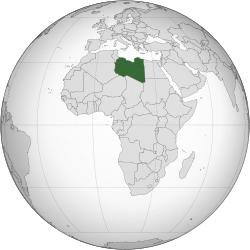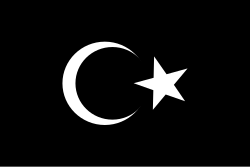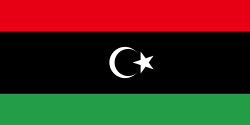Kongeriget Libyen
Kongeriget Libyen المملكة الليبية Al-Mamlakah Al-Lībiyya | |||||||||||||
|---|---|---|---|---|---|---|---|---|---|---|---|---|---|
| 1951–1969 | |||||||||||||
Nationalmelodi: Libyen, Libyen, Libyen | |||||||||||||
 | |||||||||||||
| Hovedstad | Tripoli/Benghazi/Baydaa | ||||||||||||
| Sprog | Arabisk Berbisk Italiensk | ||||||||||||
| Demonym | libyer | ||||||||||||
| Regeringsform | Konstitutionelt monarki | ||||||||||||
| Konge | |||||||||||||
• 1951–1969 | Idris 1. | ||||||||||||
| Premierminister | |||||||||||||
• 1951–1954 | Mahmud al-Muntasir | ||||||||||||
• 1965–1967 | Hussein Maziq | ||||||||||||
• 1968–1969 | Wanis al-Qaddafi | ||||||||||||
| Lovgivende forsamling | Parlament | ||||||||||||
• Overhus | Senatet | ||||||||||||
• Underhus | Repræsentanternes Hus | ||||||||||||
| Historie | |||||||||||||
• Uafhængighed | 24. december 1951 | ||||||||||||
• Statskup | 1. september 1969 | ||||||||||||
| Areal | |||||||||||||
• 1954 | 1.759.530 km² | ||||||||||||
| Befolkning | |||||||||||||
• Anslået 1954 | 1.091.830 | ||||||||||||
• Tæthed | 0,6 /km² | ||||||||||||
| Valuta | Libyske pund | ||||||||||||
| |||||||||||||
a Kongeriget havde to hovedstæder. | |||||||||||||
Kongeriget Libyen blev oprettet da FN i 1951 besluttede at oprette et kongedømme i Libyen under kong Idris 1. af Libyen. Oberst Muammar al-Gaddafi foretog 1. september 1969 et statskup mens Kong Idris 1. var i Tyrkiet til medicinsk behandling.
Libyens forfatning
Under forfatningen fra oktober 1951 styredes det federale monarki Libyen af kong Idris, og hans arvinger havde ret til at arve tronen. Kongen havde stor politisk magt.
Regeringen bestod af en premierminister og et ministerråd udpeget af kongen, og denne var ansvarlig over for Libyens deputeretkammar, underhuset. Libyens senat, overhuset, bestod af 8 repræsentanter fra hver provins. Halvdelen af senatorerne udnævntes af kongen, som havde vetoret i alle spørgsmål samt ret til at opløse underhuset. Provinsernes selvstyre udøvedes af lokale regeringer og besluttende organer. Tripoli og Benghazi fungerede som hovedstæder.
Administrativ inddeling
Provinser
Fra selvstændigheden og frem til 1963 bestod kongeriget af tre provinser: Tripolitania, Cyrenaica og Fezzan, der var Libyens tre historiske regioner. Autonomien blev udøvet gennem provinsregeringer og lokale besluttende forsamlinger.
| Provins | Hovedstad | Areal[1] |
|---|---|---|
| Tripolitanien | Tripoli | 276.000 km2 |
| Cyrenaica | Benghazi | 850.000 km2 |
| Fezzan | Sabha | 631.000 km2 |
Omordningen i 1963
Efter forandringer i forfatningen 1963 afskaffedes føderalismen, og de tre provinser blev 10 governorates (muhafazah på arabisk) hvilke styredes af en udpeget guvernør.[2] [3]
- Bayda, tidligere en del af Cyrenaica
- Al Khums, tidligere en del af Tripolitania
- Awbari, tidligere en del af Fezzan
- Az Zawiyah, tidligere en del af Tripolitania
- Benghazi, tidligere en del af Cyrenaica
- Darnah, tidligere en del af Cyrenaica
- Gharian, tidligere en del af Fezzan og Tripolitania
- Misrata, tidligere en del af Tripolitania
- Sabha, tidligere en del af Fezzan
- Tarabulus, tidligere en del af Tripolitania
Udenrigspolitik
I sin udenrigspolitik regnedes Kongeriget Libyen til den konservative traditionelle blok i det Arabiske forbund, som landet blev medlem af i 1953.[4]
Statskup og monarkiets afskaffelse
Monarkiet ophørte den 1. september 1969, da en gruppe militære ledere under Muammar Gaddafi gennemførte et statskup mod kong Idris, da han var i Tyrkiet til en medicinsk behandling. Kupmagerne arresterede hærchefen.
Noter
- ^ Villard, Henry Serrano (1956), Libya: the new Arab kingdom of North Africa, Cornell University Press, s. 26
- ^ Modern history in politics Arkiveret 6. august 2017 hos Wayback Machine (in Arabic). Libya's future.
- ^ "Municipalities of Libya"
- ^ Federal Research Division of the Library of Congress, (1987), "Independent Libya", U.S. Library of Congress. läst 14 juli 2006.
Koordinater: 32°54′08″N 13°11′09″Ø / 32.90222°N 13.18583°Ø
Medier brugt på denne side
Traditional banner of the Senussi and flag of Cyrenaica from 1949-1951.
Forfatter/Opretter: Пакко, Licens: CC BY-SA 3.0
Emblem of the Kingdom of Libya, known as the "Crown of Libya", after a design used during 1952-1969.
The constitution of the Kingdom of Libya of 1952 in article 7 describes the flag, but not the emblem. No official description is available at present (due to the restrictions placed on government archives since the military coup of 1969), and the design is reconstructed from many variants in shape and color schemes. The 24dec1951.com website conducted research into the design as represented in official government sources of 1952-1969, and describes the emblem as follows:
- Top Crown adorned with a white Crescent and five-pointed star at its summit, at which five visible side frames originating from a ring at the base converge. The star studded base and frame contain a velvet black head cover like object.
- The Top Crown is supported at its base by two beautiful plantar designs; in the form of three intertwined C and S scroll shapes.
- Two massive “Shoulder” frames contain the body of the crown from the right and left [...]. Each side is a complex formation of intertwined branches in the shape of an S Curve, which is essentially two back-to-back C scrolls; the larger one of which terminates in a large beautiful spiral at the top. [...]
- The background color of the large interior below the Top Crown can be white or transparent, although this is not evident in the picture of the Libyan pound. The background color of the center region surrounding the large white Crescent and Star is black as in the center stripe of the Libyan flag.
- A white ring with thin black borders, surrounds the center large white Crescent and Star.
- Nine five-pointed white stars surround the center ring.
- Large white crescent.
- Five pointed star located well above the perimeter of the crescent. This differs from the flag, which places the star at the extremities of the crescent.
- A Center Crown, seated above the ring containing the Crescent and Star. Its design is identical to the Top Crown, except for being smaller in size.
- Plantar/ floral ornamentation similar to #2 above, providing variation and connectivity to the base.
- At the base, an elegant design that resembles a document scroll with a ring tie at its center. It is noted that the color scheme of the crown is most likely white for the stars and crescents, black and white (or transparent) for spaces, and gold for the crowns and frames. [...]
Flag of Libya, used from 1972 to 1977.
The Ottoman Turks conquered the country in the mid-16th century, and the three States or "Wilayat" of Tripolitania, Cyrenaica and Fezzan (which make up Libya) remained part of their empire with the exception of the virtual autonomy of the Karamanlis. The Karamanlis ruled from 1711 until 1835 mainly in Tripolitania, but had influence in Cyrenaica and Fezzan as well by the mid 18th century.
Orthographic map of Libya
Forfatter/Opretter: Thommy, Licens: CC0
Flag of the Territory of Fezzan-Ghadames from c. 1947 to 24 December 1951.









